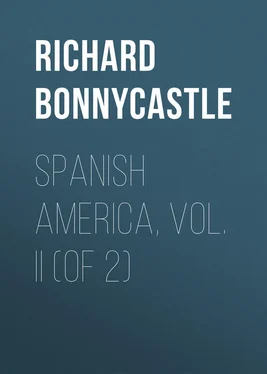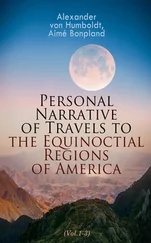Richard Bonnycastle - Spanish America, Vol. II (of 2)
Здесь есть возможность читать онлайн «Richard Bonnycastle - Spanish America, Vol. II (of 2)» — ознакомительный отрывок электронной книги совершенно бесплатно, а после прочтения отрывка купить полную версию. В некоторых случаях можно слушать аудио, скачать через торрент в формате fb2 и присутствует краткое содержание. Жанр: foreign_antique, foreign_prose, на английском языке. Описание произведения, (предисловие) а так же отзывы посетителей доступны на портале библиотеки ЛибКат.
- Название:Spanish America, Vol. II (of 2)
- Автор:
- Жанр:
- Год:неизвестен
- ISBN:нет данных
- Рейтинг книги:4 / 5. Голосов: 1
-
Избранное:Добавить в избранное
- Отзывы:
-
Ваша оценка:
- 80
- 1
- 2
- 3
- 4
- 5
Spanish America, Vol. II (of 2): краткое содержание, описание и аннотация
Предлагаем к чтению аннотацию, описание, краткое содержание или предисловие (зависит от того, что написал сам автор книги «Spanish America, Vol. II (of 2)»). Если вы не нашли необходимую информацию о книге — напишите в комментариях, мы постараемся отыскать её.
Spanish America, Vol. II (of 2) — читать онлайн ознакомительный отрывок
Ниже представлен текст книги, разбитый по страницам. Система сохранения места последней прочитанной страницы, позволяет с удобством читать онлайн бесплатно книгу «Spanish America, Vol. II (of 2)», без необходимости каждый раз заново искать на чём Вы остановились. Поставьте закладку, и сможете в любой момент перейти на страницу, на которой закончили чтение.
Интервал:
Закладка:
This isle they soon abandoned, and not a Spaniard was then left in any part of the continent from Paria to Darien. Las Casas, mortified beyond every thing, by the failure of his splendid schemes, shut himself up in the Dominican convent at Hispaniola. Here he devoted himself to the performance of religious duties, still keeping in mind the great object of his ambition. The sufferings of the Indians increasing daily, and a chapter of his order at Chiapa in New Spain, having made him their messenger to Europe, on some important affairs, he once more revisited Madrid in 1542, and took a favourable opportunity of pleading the cause of the injured Indians before Charles V. He also composed a treatise, which he called "A Brief Relation of the Destruction of the Indians;" in which was painted, in the most pathetic and forcible manner, the enormities which had taken place in every country of the New World which the Spaniards had visited.
This work created the most lively sensations throughout Europe, and such a general abhorrence of the cruel measures of the adventurers, that the Spanish court thought fit to adopt some measures to silence the universal clamour. New regulations were adopted, some of which tended to ameliorate the condition of the unfortunate Americans; and Las Casas was elevated to the dignity of bishop of Chiapa, in order to afford every relief in the power of the church to bestow.
He returned to America in 1544, and continued in this see until 1551, exerting himself in every possible manner to attain the object of his wishes; in which he succeeded greatly, but his health failing in 1551, he resigned his bishopric, and once more revisited his native country; in the same year, and for five years subsequent to his return, he lived in Madrid, still exerting all his influence to consolidate the measures which had been taken for the prosperity of the people to whom he was so much attached; at last nature became worn out, and this indefatigable, and benevolent man, closed his career in 1556, in the 92d year of his age.
Besides the work alluded to above, he wrote several others, among which, is a "General History of the Indies," of which Antonio de Herrera is said to have availed himself in the compilation of his celebrated history of the New World.
FEATURES, CLIMATE, &C
The provinces of Barcelona and Cumana are extremely mountainous; the first branch from the main chain of the Andes running through these districts, and terminating in the ocean at the gulf of Paria.
This ridge gives birth to the rivers which flow into the Orinoco on the south, and into the Caribbean sea on the north, and contains some highly picturesque and singular scenery; the most noted parts of which will be hereafter described.
The climate of this government varies according to the situation of its districts, on the high land of the mountains, or in the valleys or plains of the interior.
Capitals. – The chief town of New Andalusia is Cumana, where the governor of the two provinces usually resides. The chief town of New Barcelona, is Barcelona.
Cumana is situated in 10° 27' 52" north latitude, and 64° 9' 47" west longitude, a mile from the battery of the Boca, or mouth of the harbour, between which and the town extends a great plain, called El Salado. The port is formed by the fine river Manzanares, which runs through the town. East of the city is another extensive plain, and north of it a rocky mass, on which stands the citadel of St. Antonio. The city occupies the space between the citadel, the river Manzanares, and another smaller stream called the Santa Catalina, and the plains which surround it are highly cultivated; that towards the sea having an Indian suburb and gardens filled with sapotes, mameis, plantains, &c. The suburb is divided into three parishes; on the east is that of Sarritos, on the south-east, St. Francisco, and the great town of the Guayqueria Indians. Cumana is one of the oldest cities of the continent, and was built by Gonzalo Ocampo in 1520.
In the city of Cumana are no very remarkable buildings, owing to the fatal effects of the last earthquake. There is only one parish church and two convents, but additions are daily making to it, which will render it a fine town.
This city is remarkable for the purity and healthiness of its climate, on account of the heat being moderated by the sea-breezes; the most fatal disorders are fluxes, which carry off numbers of children annually, owing to the great use they make of green indigestible fruits. The women, particularly the Indians, are very prolific, which in some measure compensates for the loss annually experienced of the younger branches of society. The population of Cumana amounts at present to 16, or 17,000 souls, of which, two-fifths are Indians of the Guayqueria, Chayma, and other tribes. Of these, the Guayquerias are the most noted tribe not only of Cumana, but of Caraccas; they are a branch of the Guarounoes, who inhabit the swampy island, at the mouth of the Orinoco; but they have now become so incorporated with the Spaniards, that for the last century they have spoken the Spanish language only. When Columbus was on this coast, his people saw these Indians fishing with long poles pointed at one end, and tied to a cord at the other; demanding of them the name of their country, they immediately replied Guiake, which signified pointed stick; the sailors thought this was the name of the tribe, and accordingly called them Guaikerias, which name they have since retained.
These people, who also inhabit the islands, show to Europeans with pride the Punta de la Galera, so called, because Columbus's vessel touched there, as well as port Manzanillo, where they swore fidelity in 1498 to the whites, which vow they have never violated. The Guayquerias are the pilots of the coast of Cumana, and their suburb is composed of rows of uniform low buildings disposed into the form of streets, which have a very neat appearance.
On a naked rock which commands the city, 100 feet above the level of the sea, is the castle of St. Antonio, which commands the place. There is also another fort in ruins, on the south-west; and the entrance into the port is defended with inconsiderable batteries, but the military positions of Cumana are of little importance, as the citadel is commanded by a part of the same rock on which it stands; the chief defence of this post being a thick wood of the cactus, whose thorny shoots defy admission into its recesses.
The entrance of the harbour of Cumana is highly picturesque, the city rising out of the plain backed by the citadel, its rocks and groves, the plantations of cocoa-nuts, cassias, capers, and arborescent mimosas; the shores covered with alcatras or brown pelicans, egrets, and flamingoes. The beauty of the river, and the clear blue of the sky, contrasted with the dark and gloomy appearance of the mountains in the interior, conspire to afford a landscape of the most captivating character.
The European inhabitants, and the descendants of Europeans, are noted for their great politeness and hospitality to strangers; they are chiefly occupied in commercial enterprize, this and Barcelona being ports where much trade is carried on. The manner and customs of these people is nearly allied to those of their brethren in the other great cities of Spanish America. One of the most singular of their customs is that of passing most of their evenings sitting on chairs placed in the river.
In this city, the first question in a morning is, "Is the water cool?" Their conversaziones are carried on in the rivers where the evening parties are mostly spent in talking about the weather, the news, and in smoking. All the inhabitants of the town it is said can swim, and the children pass the greater part of their time in the water. The alligator is not dangerous at Cumana, as they are seldom seen, and are only of the smallest kind; the chief fear that the women have whilst bathing is from the dolphin, which sometimes comes up the river and spouts like the whale.
Читать дальшеИнтервал:
Закладка:
Похожие книги на «Spanish America, Vol. II (of 2)»
Представляем Вашему вниманию похожие книги на «Spanish America, Vol. II (of 2)» списком для выбора. Мы отобрали схожую по названию и смыслу литературу в надежде предоставить читателям больше вариантов отыскать новые, интересные, ещё непрочитанные произведения.
Обсуждение, отзывы о книге «Spanish America, Vol. II (of 2)» и просто собственные мнения читателей. Оставьте ваши комментарии, напишите, что Вы думаете о произведении, его смысле или главных героях. Укажите что конкретно понравилось, а что нет, и почему Вы так считаете.












